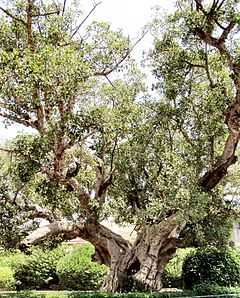Ficus sycomorus
| Ficus sycomorus | |
|---|---|
 | |
| Scientific classification | |
| Kingdom: | Plantae |
| (unranked): | Angiosperms |
| (unranked): | Eudicots |
| (unranked): | Rosids |
| Order: | Rosales |
| Family: | Moraceae |
| Genus: | Ficus |
| Subgenus: | Sycomorus |
| Species: | F. sycomorus |
| Binomial name | |
| Ficus sycomorus L. | |
| Range | |
|
| |

Ficus sycomorus, called the sycamore fig or the fig-mulberry (because the leaves resemble those of the Mulberry), sycamore, or sycomore, is a fig species that has been cultivated since ancient times. (Sycamore has been used for a variety of plants, and in England is widely used to refer to the Great Maple (Acer pseudoplatanus). For clarity this species of fig is usually exclusively referred to as Sycomore.
Distribution

Ficus sycomorus is native to Africa south of the Sahel and north of the Tropic of Capricorn, also excluding the central-west rainforest areas. It also grows naturally in Lebanon, where the famous Gemmayzeh Street is named after its Arabic name Gemmayz, the southern Arabian Peninsula, in Cyprus and in very localized areas in Madagascar, and has been naturalised in Israel and Egypt. In its native habitat, the tree is usually found in rich soils along rivers and in mixed woodlands.
Description
Ficus sycomorus grows to 20 m tall and 6 m wide with a dense round crown of spreading branches. The leaves are heart-shaped with a round apex, 14 cm long by 10 cm wide, and arranged spirally around the twig. They are dark green above and lighter with prominent yellow veins below, and both surfaces are rough to the touch. The petiole is 0.5–3 cm long and pubescent. The fruit is a large edible fig, 2–3 cm in diameter, ripening from buff-green to yellow or red. They are borne in thick clusters on long branchlets or the leaf axil. Flowering and fruiting occurs year-round, peaking from July to December. The bark is green-yellow to orange and exfoliates in papery strips to reveal the yellow inner bark. Like all other figs, it contains a latex.
Cultivation
According to botanists Daniel Zohary (b. 1926) and Maria Hopf (1914-2008), The Ancient Egyptians cultivated this species "almost exclusively." Remains of F. sycomorus begin to appear in predynastic levels and in quantity from the start of the third millennium BCE. It was the ancient Egyptian Tree of Life.[1] Zohary and Hopf note that "the fruit and the timber, and sometimes even the twigs, are richly represented in the tombs of the Egyptian Early, Middle and Late Kingdoms." In numerous cases the parched fruiting bodies, known as sycons, "bear characteristic gashing marks indicating that this art, which induces ripening, was practiced in Egypt in ancient times."[2]
Although this species of fig requires the presence of the symbiotic wasp Ceratosolen arabicus to reproduce sexually, and this insect is extinct in Egypt, Zohay and Hopf have no doubt that Egypt was "the principal area of sycamore fig development." Some of the caskets of mummies in Egypt are made from the wood of this tree. In tropical areas where the wasp is common, complex mini-ecosystems involving the wasp, nematodes, other parasitic wasps, and various larger predators revolve around the life cycle of the fig. The trees' random production of fruit in such environments assures its constant attendance by the insects and animals which form this ecosystem.
Gardens
In the Near East F. sycomorus is an orchard and ornamental tree of great importance and very extensive use. It has wide-spreading branches and affords shade.
In literature
In the Bible, the sycomore is referred to seven times in the Old Testament [Hebrew shiqmah; Strong's number 8256) and once in the New Testament (Greek sycomorea; Strong's number 4809).
- In the Psalms, sycomores are listed with vines as sources of food destroyed in the plagues inflicted on the Egyptians Ps 78:47
- King David appointed an officer to look after the olives and sycomores of the western foothills 1Chron 27:28
- King Solomon made [up-market] cedars as common as sycomores 1Kings 10:27 = 2Chron 1:15,2Chron 9:27
- In condemning his people's arrogance the prophet Isaiah also makes a contrast between sycomores and cedars Isaiah 9:10.
- The prophet Amos refers to his secondary occupation as a dresser or tender of sycomores Amos 7:14; this involved slashing the fruits to induce ripening (vd citation from Zohary & Hopf supra)
- In Luke's Gospel, little Zacchaeus resorted to climbing a sycomore in order to get a better view of Jesus in Jericho Luke 19:4.
- In the Mishnah, in chapter 9 of tractate Shevi'it of order Zera'im, the borders of the various districts of the Land of Israel are delineated. The Upper Galillee is defined as the area north of Kfar Hananya where the sycamore does not grow; the Lower Galillee is the area south of Kfar Hananya where the sycamore does grow.
- The Talmud, tractate Berkhoth mentions sycomore in reference to tithing and its subsequent appropriate blessing
- In Luke's Gospel, the Fig tree is used as a parable [3]
Notes
- ↑ "Death and salvation in ancient Egypt", Jan Assmann, David Lorton, Translated by David Lorton, p171, Cornell University Press, 2005, ISBN 0-8014-4241-9
- ↑ Daniel Zohary and Maria Hopf, Domestication of plants in the Old World, third edition (Oxford: University Press, 2000), p. 165
- ↑ bibleverse Luke 13:6–9
External links
| Wikimedia Commons has media related to Ficus sycomorus. |
- Figweb.org - Ficus sycomorus
- U-landslære Approaches to Development - Sycamore Fig
- Botswana Tourism: Flora and Fauna
- PBS Nature documentary: "The Queen of Trees" (on the Sycamore fig in Kenya)
